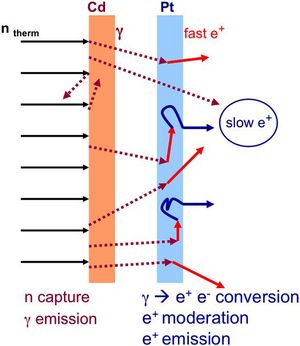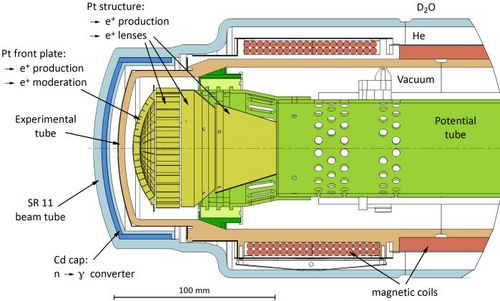The positron beam facility at NEPOMUC
The neutron induced positron source NEPOMUC (NEutron induced POsitron source MUniCh) at FRM II is the world’s strongest source of mono-energetic positrons. The intensity of NEPOMUC is up to three orders of magnitude higher than conventional lab-based positron beams. Besides the enhanced signal-to-noise ratio and much lower measurement time NEPOMUC allows a new class of experiments with improved energy or time resolution. Therefore, new insights become realizable in a large variety of experiments in solid-state physics, material science, surface science and in fundamental physics of anti-matter.
Presently, four spectrometers are connected to the positron beam facility and an open beam port is available for additional short-term positron experiments. Besides these instruments, additional experiments are performed using 22Na as positron emitter.
The NEPOMUC source - principle

NEPOMUC provides an intensity of 9.0±0.8 · 108 moderated positrons per second at a positron beam energy of 1 keV [1]. This is hence the world highest intensity of a mono-energetic positron beam reported so far. The beam diameter in a 60 mT guide field amounts to typically 7 - 9 mm (FWHM).
The principle of the intense positron source at FRM II NEPOMUC is based on thermal neutron capture in cadmium. This process is completely dominated by 113Cd due to its enormous cross section for thermal neutron capture:
113Cd(n,γ)114Cd, σ= 20600 barn !!
The absorption of the prompt high-energy γ-radiation (up to 9MeV) generates positrons by pair production with a maximum intensity at a positron energy of about 800 keV. After moderation in platinum thermalized positrons can diffuse to the surface and are emitted into the vacuum (see figure 1).
[1] Unprecedented intensity of a low energy positron beam; C. Hugenschmidt, B. Löwe, J. Mayer, C. Piochacz, P. Pikart, R. Repper, M. Stadlbauer, and K. Schreckenbach; Nucl. Instr. Meth. A (2008), available online:doi:10.1016/j.nima.2008.05.038
The NEPOMUC source - design
Some considerations for the optimal design:
- The conversion γ → e+e- should take place in matter with high nuclear charge Z, since the cross section for pair production is approximately proportional to Z2. Therefore, platinum is used as converting material where the cross section for pair production is about 11% higher than in tungsten.
- Platinum is also applied as positron moderator due to its negative positron work function.
- To produce a great amount of positrons the volume of the converting material should be maximized.
- Thin foils enable the thermalized positrons to reach the surface. Taking into account the optimal thickness of about 0.2 - 0.8 mg/cm2 the surface to volume ratio of platinum has to be maximized to enhance the yield of moderated positrons.
- Macroscopic burn-up of 113Cd: Monte Carlo calculations showed that at the present fixed position the unperturbed thermal neutron flux is 2.2· 1014 n/cm2s. The operation time is limited by the burn-up of 113Cd (natural abundance 12.2%). In order to increase the operation time a 3 mm thick cadmium cap with highly enriched 113Cd (80 % enrichment) is chosen according to a burn-up time of about 25 years of reactor operation.
- Neutron induced radiation damage: The closer the source to the reactor core the higher the flux of fast neutrons, leading to neutron induced radiation damage. These defects trap positrons in the moderator material and hence reduce the low energy positron yield.
- Depression of neutron flux: The n-flux depression caused by the cadmium cap should not significantly perturb the neutron flux of neutron beam guides in the vicinity of the source.
- High thermal neutron flux: However, satisfying the pre-mentioned conditions the source should be placed in a high thermal neutron flux to finally enhance the brightness of the positron beam.

Inside the tip of a beam tube a cap of cadmium is encapsulated in aluminium (see figure 2). The sandwich structure Al-Cd-Al guarantees an almost perfect heat conduction to dissipate the heat input resulting from γ-absorption directly to the surrounding heavy water. The heart of the source consists of platinum rings acting as converter and positron moderator.
The beamline
First, the moderated positrons of the e+ source are extracted and accelerated by electric lenses. Then the beam is guided in a homogeneous longitudinal magnetic field (60 - 75 mT) into a remoderator outside the biological shield of the reactor. A switching unit allows toggling between the high-intensity primary beam and the remoderated positron beam with increased brightness. The positron beam passes a magnetic beam switch to the positron experiments.
Instrumentation
CDBS - Coincident Doppler Broadening Spectroscopy
PAES - Positron annihilation induced Auger Electron Spectroscopy
PLEPS - Pulsed Low Energy Positron System
Open beam port - recently used for the production of Ps-
SPM - Scanning Probe Microscope
